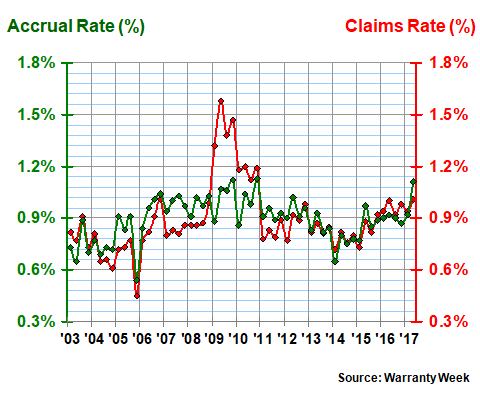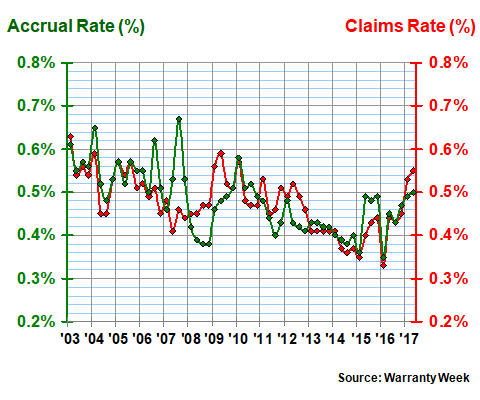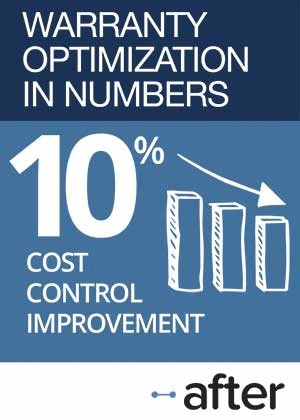Midyear Auto Warranty Expense Report:
Though passenger car sales have slowed a bit from last year's record pace, there's no sign of a slowdown among truck makers or their suppliers. More worrisome is a slow but steady rise in warranty expenses that's been under way for several years, after more than a decade of gradual cost reduction.
When automotive manufacturers began to report their warranty expenses in 2003, the entire process was primitive and inefficient. For more than a decade, they gradually reduced their warranty expense rates, until in 2014 or 2015 they hit rock bottom. Now, they're starting to climb back up, in some cases rising above their historical average rates.
Automotive warranties have traditionally accounted for upwards of 40% of the claims and accruals reported by all U.S.-based manufacturers. So it's more than an early warning for industry trends. It is the industry trend. And lately, the trend has been towards increasing costs. It's nothing terrible, but it is a reversal of a decade-long trend.
To reach this conclusion, and to better see its source, we started with a list of 169 companies primarily engaged in the manufacture of motorized vehicles and their parts. First we divided the list into two pieces: 49 automotive OEMs and 120 parts suppliers. Then we split each of those lists into two pieces each.
Four Groups
Based upon the size of vehicles manufactured, we divided the OEM list in half, consisting of 24 makers of passenger cars and small vehicles, and 25 heavy truck and large vehicle manufacturers. And then, based on the type of parts and components manufactured, we also divided the supplier list into two pieces, with 24 manufacturers of engines, transmissions, and other powertrain components going onto the third list, and 96 manufacturers of other automotive parts on the fourth list.
The top manufacturers of passenger cars were of course General Motors Co. and Ford Motor Co. Fiat Chrysler Automobiles, which is based in Europe and reports its warranty expenses in euro, was not included. However, manufacturers of other small motorized vehicles, such as Harley-Davidson Inc. and Polaris Industries Inc., were included.
The companies on the large vehicle manufacturer list included truck makers such as Navistar International Corp. and Paccar Inc.; agricultural machinery makers such as Deere & Co. and AGCO Corp.; and construction equipment makers such as Caterpillar Inc., Terex Corp., and Oshkosh Corp. It also included recreational vehicle makers such as Thor Industries Inc. and Winnebago Industries Inc., so there is inevitably some overlap with the companies on last week's list.
The powertrain suppliers included companies such as Cummins Inc., Eaton Corp., BorgWarner Inc., and Dana Inc. The list of other suppliers included Delphi Automotive, Illinois Tool Works Inc., Goodyear Tire & Rubber Co., Titan International Inc., Westinghouse Air Brake Technologies Corp., and Tenneco Inc., among others.
For each company, we collected three metrics for the 58 quarters between the start of 2003 and the middle of 2017: claims paid, accruals made, and product sales. And then we divided both claims and accruals by product sales in order to calculate a pair of percentages for each company's claims and accrual rates.
OEM Claims Cost
The charts below detail these quarterly measurements in eight different ways. Figure 1 details the quarterly claims payments by the U.S.-based automotive OEMs. The small vehicle makers are in dark blue, while the large vehicle makers are in light blue.
Figure 1
Automotive OEM Warranties
Claims Paid Worldwide by U.S.-based Manufacturers
(in US$ millions, 2003-2017)

Notice that the passenger car and small vehicle makers paid out $1.6 billion in claims during the second quarter, their least quarterly amount since the beginning of 2014. That's because claims fell by $183 million since the second quarter of 2016, and by $127 million in the first half of 2017. In fact, it was the third consecutive quarterly decline in claims payments, something that hasn't happened since just after GM's ignition key crisis subsided in early 2015.
Truck manufacturers also saw their claims payments fall, down by $23 million in the second quarter of 2017 to $663 million. But that was a smaller decline in both dollar terms and as a percentage of the year-ago total, which in turn pushed the large vehicle's share of the total pie closer to 30% than it's been in years.
For the first half of 2017, however, the declines in claims payments by both groups were slight at best. Also, from the first to the second quarter of 2017, claims actually rose slightly for the truck makers (although this is probably a seasonal effect).
GM, Ford, and Deere scored the biggest year-over-year declines in claims payments during the second quarter, while Terex, Thor, and Navistar saw the biggest dollar increases. On a proportional basis, however, there was a larger percentage decline at AGCO, and a bigger percentage increase at Polaris.
OEM Accruals
Warranty accruals, the amounts each manufacturer sets aside to finance future warranty work as products are sold, turned in a mixed message during the second quarter of 2017. For large vehicle makers, accruals were up by $150 million, while for small vehicle makers, accruals were down by $148 million. For the first half of 2017, large vehicle makers accrued significantly more than they did in the first half of 2016, while small vehicle makers accrued about the same amount.
In Figure 2, the most prominent feature is the towering expense seen in the first half of 2014. That's almost entirely due to GM's ignition key recall expenses, which were set aside as accruals during those two quarters and then were gradually paid out in claims over the next several quarters. Without that spike, accrual expenses have been generally flat for most of the past six years.
Figure 2
Automotive OEM Warranties
Accruals Made Worldwide by U.S.-based Manufacturers
(in US$ millions, 2003-2017)

Absent any compelling changes in the average cost or frequency of repairs, warranty accruals generally rise and fall in proportion to sales. However, in the cases of both these segments, the changes in accruals were proportionally larger than changes in product sales. For the large vehicle manufacturers, accruals rose 25% while sales rose only 5%. For the small vehicle makers, accruals fell 9% while sales fell only 3%. In other words, the truck makers see warranty expenses rising faster than sales, while the carmakers see the opposite.
The OEMs that raised their accruals the most were Caterpillar, Deere, Thor, and Tesla Inc. The OEMs that reduced their accruals the most included GM, Paccar, and Polaris. On a percentage basis, the top gainers and decliners were roughly the same, though Harley-Davidson also cut its quarterly accruals by a comparatively large percentage.
OEM Expense Rates
By dividing both the claims and accrual totals in Figures 1 and 2 by the corresponding sales figures, we derived a pair of percentages for both the large and small vehicle manufacturers. And we found that over the past 14-1/2 years, the car and small vehicle manufacturers have generally reported their claims and accrual rates to be 0.2% to 0.3% higher than those reported by the truck and large vehicle manufacturers. It's not much, but it's statistically significant.
In Figure 3, we've charted the warranty expense rates for the car and small vehicle makers. The 2009 spike in claims has more to do with plummeting sales rates during the recession, while the 2014 spike in accruals is heavily linked to GM's ignition key recalls.
Figure 3
Passenger Car & Small Vehicle Makers
Average Warranty Claims & Accrual Rates
(as a % of product sales, 2003-2017)

In Figure 4, we've charted the warranty expense rates of the truck and large vehicle manufacturers over the past 58 quarters. Once again, the 2009 spike has more to do with the decline in sales than with a real rise in claims (the data in Figure 1 confirms that). There's no 2014 spike, though there is an increase in expense rates in 2016 and early 2017 that we suspect is linked to problems at Caterpillar and Deere.
Figure 4
Heavy Truck & Large Vehicle Makers
Average Warranty Claims & Accrual Rates
(as a % of product sales, 2003-2017)

Over the long term, based on 116 measurement, the small vehicle makers have averaged a warranty expense rate of 2.4%, with a standard deviation of 0.4%. Meanwhile, the large vehicle makers have averaged 2.1%, with a standard deviation of 0.3%. This suggests that the larger vehicle makers have both lower and less volatile claims and accrual rates than the small vehicle makers.
Supplier Trends
In Figures 5 through 8, we are going to repeat the analysis above, substituting the warranty expense reports of suppliers for the OEMs covered above. In general, the suppliers report much smaller warranty expenses than the OEMs, in terms of both the dollars involved and the percentages of sales revenue those expenses represent. However, there is a noticeable difference between the warranty expenses of companies making engines and transmissions, and the companies supplying other automotive components to the OEMs.
With heavy trucks, buses, and RVs, the engines are frequently sold separately from the chassis, and therefore have separate warranties, sometimes from different companies. For passenger cars, light trucks, and motorcycles, the OEMs frequently assemble and warrant the entire unit as a single entity.
The reason we mention this is because the main reason the carmakers have higher warranty expense rates than the truck manufacturers is because whichever companies issue the warranties directly to the end user customers seem to attract the highest warranty costs. And since the truck engine and transmission manufacturers also issue their warranties directly to the end user customers, they raise the averages for all powertrain suppliers higher than is the case for suppliers of other parts and components.
In Figure 5 we're looking at the claims payments of the two groups of suppliers: powertrain and other. In contrast with the OEMs, the two groups seem to more equally share the claims cost between them. While the OEM expenses were typically split 70/30 in favor of the smaller vehicles, the supplier expenses were split much closer to 50/50.
There hasn't been a tremendous amount of variation in the quarterly totals for either group for multiple years. The powertrain suppliers, in fact, reported just a $3.3 million increase in claims from the second quarter of 2016 to the second quarter of 2017. Sequentially, the increase from the first to second quarters of 2017 was a slightly larger $11 million. But even on a percentage basis, the changes aren't huge.
Figure 5
Auto Parts Supplier Warranties
Claims Paid by U.S.-based Companies
(in US$ millions, 2003-2017)

There have been, however, some massive increases in warranty claims reported by some of the individual companies. For instance, Delphi went from paying $20 million in claims during the second quarter of 2016 to paying $48 million in the second quarter of 2017. Cummins saw a $7 million increase, and BorgWarner saw a $5 million increase. On a percentage basis, Wabco Holdings also saw a large increase in claims.
Only a handful of suppliers saw any meaningful declines in claims cost, with Westinghouse Air Brake and Allison Transmission leading the way. On a percentage basis, those two plus Tenneco and Titan International saw the largest declines in claims payments from 2016 to 2017.
Supplier Accruals
Both powertrain and other suppliers increased their accruals during the second quarter of 2017. In Figure 6, we're tracking the quarterly totals, which were up by $55 million year-over-year for the powertrain suppliers and by $18 million for the other suppliers.
Figure 6
Auto Parts Supplier Warranties
Accruals Made by U.S.-based Companies
(in US$ millions, 2003-2017)

It was, in fact, the highest quarterly accruals total ever recorded for the 24 powertrain component suppliers. And it was caused almost entirely by a massive increase in warranty expenses reported by Cummins, which increased its quarterly accrual total from $88 million in the second quarter of 2016 to $147 million in the second quarter of 2017. However, there were also much smaller accrual increases reported by BorgWarner, Tenneco, Westinghouse Air Brake, and Dana Inc., among others.
While it was the largest-ever accrual total reported by the powertrain suppliers, it was a fairly routine quarter for the other parts suppliers. As can be seen in Figure 6, there were multiple quarters from 2005 to 2007 in which this group reported upwards of $250 million in warranty accruals. But they've exceeded $200 million in only two of the last 14 quarters.
Supplier Expense Rates
Finally, let's take a look at the claims and accrual rates of the suppliers. These percentage rates are calculated by taking the raw dollar totals from Figures 5 and 6 and dividing them by the corresponding sales totals.
In Figure 7, the powertrain suppliers saw their claims rate soar in 2009 because of the decline in sales during the recession. They'd generally fallen in the years afterwards, but they seem to have hit bottom in early 2014 and have been rising since.
Figure 7
Powertrain Component Manufacturers
Average Warranty Claims & Accrual Rates
(as a % of product sales, 2003-2017)

Note that the latest measurement of this group's accrual rate, at 1.1%, is its highest level since the end of 2010. And their latest claims rate is the first measurement over one percent since then as well. It's closely linked to the expense increase at Cummins, which the company said was caused by problems with "certain 2013 and 2014 engines."
Declining Expense Rates
In Figure 8, the average warranty expense rates of the 96 non-powertrain parts and component suppliers show a generally downward trend for more than a decade from 2003 until early 2016, when both their claims and accrual rates briefly dipped below 0.4%. But they've risen back up since, to the point where their claims rate is at its highest point since early 2010, and their accrual rate is back to its historical average level of 0.5%. It's hard to blame it all on any one company, though some such as Snap-on Inc. and Delphi have seen their expense rates rise noticeably in the past year.
Figure 8
Other Auto Parts Suppliers
Average Warranty Claims & Accrual Rates
(as a % of product sales, 2003-2017)

For both the powertrain suppliers and the other parts suppliers, accruals are rising at a much faster pace than sales. This suggests that these companies see warranty costs rising soon. While product sales were up 8% for the powertrain suppliers and were up 4% for the other parts suppliers, their accruals grew significantly faster: 31% for powertrain and 11% for the others.
In general, the powertrain suppliers have reported both higher and more volatile warranty expense rates than the other suppliers. While the long-term average expense rate for the other suppliers is 0.5%, with a standard deviation of 0.1%, the powertrain suppliers have turned in expense rates closer to 1.0%, with a standard deviation of 0.2%.
That 2-to-1 ratio continues into 2017, with the other suppliers reporting averages between 0.5% and 0.6%, and the powertrain suppliers reporting expense rates between 0.9% and 1.1%. So the 2-to-1 pattern holds not only for the average, but also for the range of measurements.
Therefore, in general, the pattern within the automotive industry is this: carmakers have the highest expense rates, slightly above truck manufacturers. The next group down the list are the powertrain suppliers. And the group with the lowest expense rates of all are the other non-powertrain suppliers.








